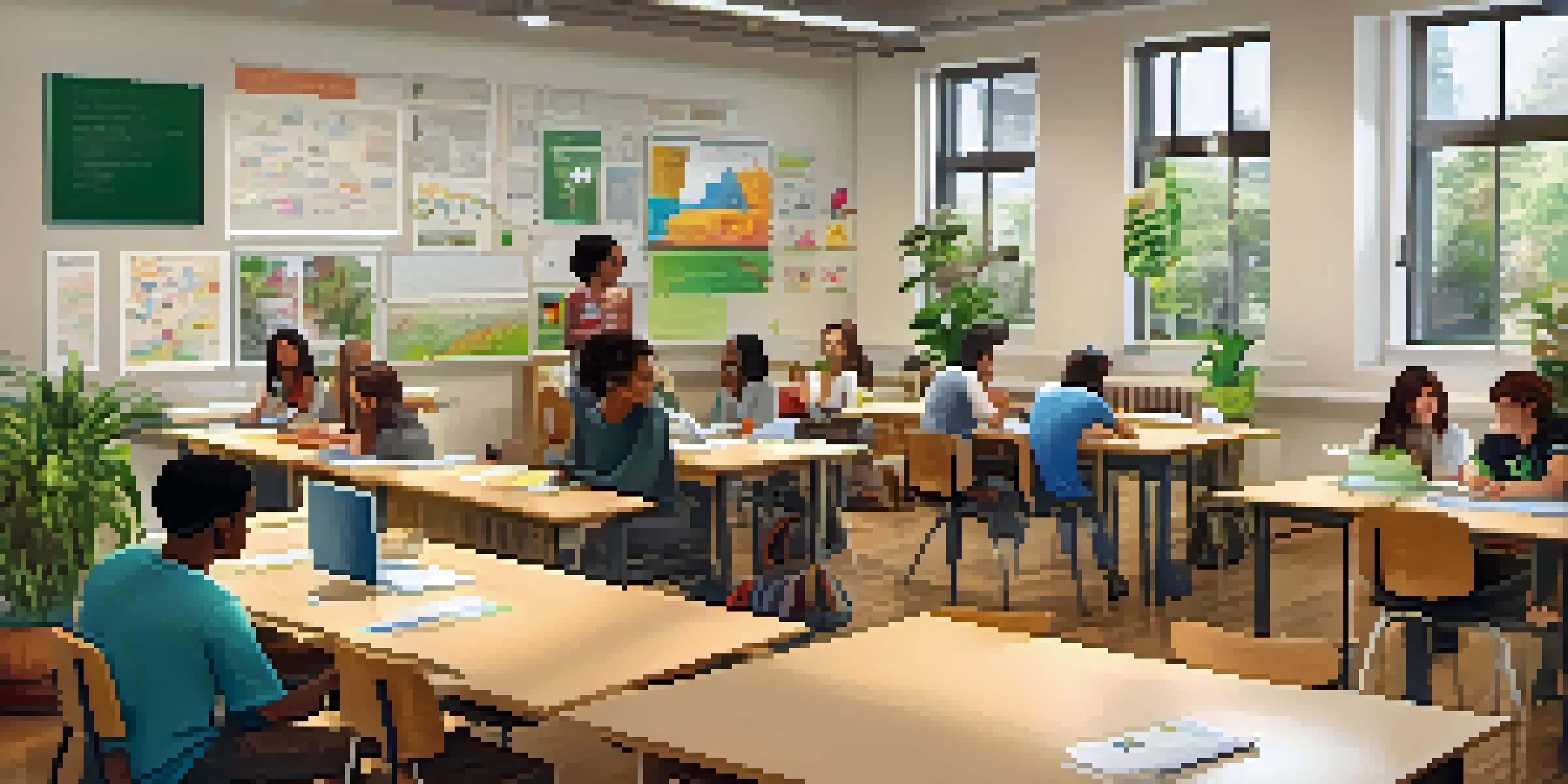Flipped Classroom: Addressing Student Anxiety and Stress

Understanding the Flipped Classroom Model
The flipped classroom is an innovative teaching approach where traditional lecture content is delivered outside the classroom, often through videos or readings. This allows students to engage with the material at their own pace, making it easier to grasp complex concepts. When they come to class, they focus on interactive activities, discussions, and hands-on projects. This model shifts the emphasis from passive listening to active learning, promoting better retention and understanding.
Education is not the filling of a pail, but the lighting of a fire.
Imagine watching a cooking show before attempting a new recipe. You can pause, rewind, and absorb the techniques at your leisure, which prepares you for the actual cooking. Similarly, the flipped classroom lets students review materials as needed, catering to different learning speeds and styles. This flexibility can significantly reduce anxiety, as students can clarify doubts before facing their peers.
Moreover, the classroom becomes a space for collaborative learning, where students can support each other. This interaction not only enhances learning experiences but also builds a sense of community, further alleviating stress. By transforming the classroom dynamic, the flipped model empowers students and encourages them to take charge of their learning.
The Link Between Traditional Learning and Student Stress
Traditional education often involves a one-size-fits-all approach, where lectures dominate and student participation is minimal. This can lead to feelings of overwhelm, particularly for those who struggle to keep up with the pace of lessons. The pressure to perform in a high-stakes environment can create significant anxiety, affecting overall academic performance and well-being.

Picture a swim class where everyone dives in at the same time, regardless of their skill level. Those who are struggling may feel out of place, leading to stress and disengagement. Traditional classrooms can feel similarly daunting, as students may hesitate to ask questions or seek help for fear of judgment. This exacerbates their anxiety, creating a vicious cycle.
Flipped Model Enhances Learning
The flipped classroom model promotes active learning by allowing students to engage with materials at their own pace before class.
In contrast, a flipped classroom allows students to prepare beforehand, making them feel more confident when they enter the classroom. They can tackle content in a familiar environment, reducing the pressure associated with immediate comprehension. By addressing these challenges, the flipped model can significantly lower levels of stress and anxiety.
Benefits of the Flipped Classroom for Student Well-Being
One of the most significant advantages of the flipped classroom is its potential to enhance student well-being. By allowing students to engage with materials at their own pace, they can better manage their time and learning processes. This autonomy fosters a sense of control, which is crucial for reducing anxiety and building confidence.
The greatest gift is not being afraid to question.
Think of it like choosing when to exercise; some people prefer to run in the morning, while others might find it easier later in the day. When students can tailor their learning schedules, they are more likely to absorb information effectively. This personalized approach helps students feel less rushed and more prepared for in-class activities, ultimately leading to a more relaxed atmosphere.
Additionally, the interactive nature of classroom time encourages social engagement, which is vital for emotional health. When students collaborate and support one another, they build relationships that can act as a buffer against stress. This community aspect of the flipped classroom not only enhances learning but also nurtures a supportive environment.
Encouraging Self-Directed Learning in Students
Self-directed learning is a key component of the flipped classroom model. By taking responsibility for their learning, students develop essential skills such as time management, critical thinking, and problem-solving. This level of engagement not only prepares them for academic success but also instills a sense of pride and accomplishment.
Consider how a gardener tends to their plants, adjusting care based on what each plant needs. Similarly, when students take charge of their education, they learn to identify their strengths and areas for improvement. This self-awareness can lead to greater resilience in facing challenges and navigating stressful situations.
Reduced Anxiety Through Preparation
By preparing before class, students feel more confident and capable, which significantly lowers anxiety.
As they cultivate these skills, students become more adept at managing their anxiety. They learn to approach tasks methodically and seek help when needed, rather than feeling overwhelmed. This empowerment can transform their educational experience and equip them for future challenges in and out of the classroom.
Creating a Safe Learning Environment
A safe learning environment is crucial for reducing anxiety, and the flipped classroom model encourages this type of atmosphere. With less pressure to perform during lectures, students are more willing to share their thoughts and questions. This openness fosters trust between students and teachers, creating a supportive setting for learning.
Imagine a cozy coffee shop where people feel comfortable discussing their ideas. The flipped classroom aims to replicate that sense of safety and community. Students can express their concerns and misconceptions without fear of judgment, helping to alleviate anxiety and encourage participation.
Moreover, teachers can provide more personalized feedback and support during class time. With more one-on-one interactions, students can receive guidance tailored to their individual needs. This nurturing approach not only enhances learning but also reassures students that they are valued and understood.
The Role of Technology in Flipped Classrooms
Technology plays a pivotal role in the flipped classroom model, serving as a bridge between students and resources. Online platforms enable access to a wealth of materials, from videos to interactive quizzes, allowing students to learn in ways that suit them best. This accessibility is particularly beneficial for those who may struggle with traditional learning methods.
Think of technology as a toolkit; the right tools can simplify complex tasks and make learning enjoyable. In the flipped classroom, students can utilize various resources to reinforce their understanding, reducing anxiety about grasping difficult concepts. This flexibility empowers them to seek out additional help and resources at their convenience.
Building Community in Classrooms
The interactive nature of the flipped classroom fosters collaboration and trust among students, enhancing their emotional well-being.
Furthermore, technology facilitates communication between students and teachers, making it easier to ask for assistance or clarification. When students feel connected and supported, their anxiety levels decrease, leading to a more productive learning experience. Embracing technology not only enhances learning but also fosters a sense of community and collaboration.
Implementing the Flipped Classroom in Diverse Settings
Implementing the flipped classroom model can be beneficial in various educational settings, from K-12 schools to universities. Each environment presents unique challenges and opportunities, but the core principles of the flipped model remain relevant. By adapting the approach to fit specific contexts, educators can address student anxiety effectively.
Consider a school in a rural area with limited access to resources. By utilizing online platforms and community partnerships, teachers can create a flipped classroom that provides students with diverse learning opportunities. This adaptability ensures that all students, regardless of their circumstances, can benefit from the model.

Moreover, as more educators embrace this approach, a wealth of resources and success stories become available. Sharing these experiences fosters a collaborative spirit among educators, encouraging them to refine their practices. As they learn from one another, the flipped classroom can become a powerful tool in promoting student well-being and reducing anxiety.